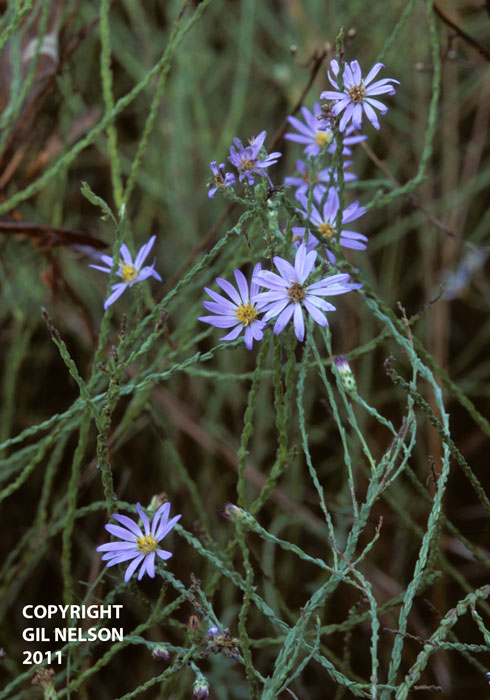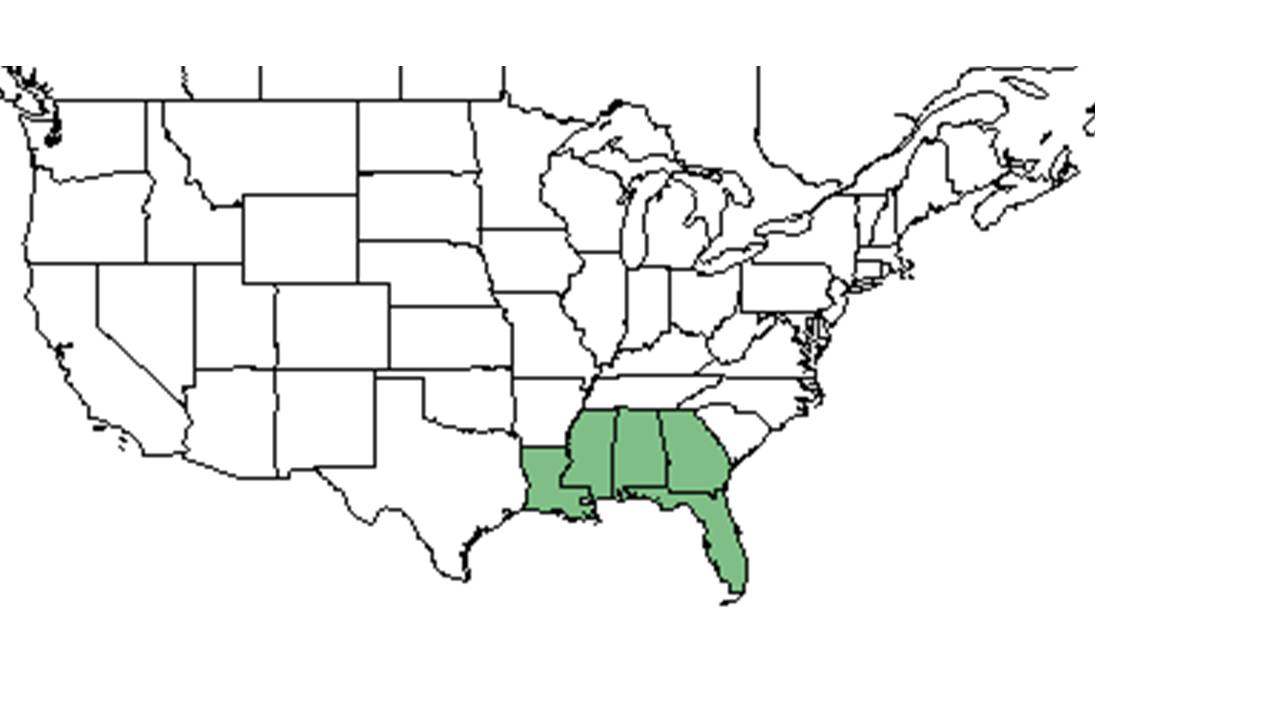Difference between revisions of "Symphyotrichum adnatum"
(→Taxonomic notes) |
|||
| Line 29: | Line 29: | ||
==Ecology== | ==Ecology== | ||
===Habitat=== <!--Natural communities, human disturbed habitats, topography, hydrology, soils, light, fire regime requirements for removal of competition, etc.--> | ===Habitat=== <!--Natural communities, human disturbed habitats, topography, hydrology, soils, light, fire regime requirements for removal of competition, etc.--> | ||
| − | In the Coastal Plain in Florida and Georgia, ''S. adnatum'' can be found in longleaf pine savannas, pine flatwood communities, annually burned pinelands, slash pine plantations, and open mixed woodlands. <ref name=fsu> Florida State University Robert K. Godfrey Herbarium database. URL: http://herbarium.bio.fsu.edu. Last accessed: July 2015. Collectors: Loran C. Anderson, Robert K. Godfrey, Leon Neel, R. A. Norris, R. Komarek, Kathleen Craddock Burks. States and Counties: Florida: Bay, Leon, Wakulla, Walton. Georgia: Thomas. Compiled by Tall Timbers Research Station and Land Conservancy. </ref> It is restricted to native groundcover with a statistical affinity in upland pinlands of South Georgia. <ref name=oster> Ostertag, T.E., and K.M. Robertson. 2007. A comparison of native versus old-field vegetation in upland pinelands managed with frequent fire, South Georgia, USA. Pages 109–120 in R.E. Masters and K.E.M. Galley (eds.). Proceedings of the 23rd Tall Timbers Fire Ecology Conference: Fire in Grassland and Shrubland Ecosystems. </ref> Soil types include loamy sand and sand. <ref name=fsu/> ''S. adnatum'' responds negatively to soil disturbance by agriculture in Southwest Georgia.<ref>Hedman, C.W., S.L. Grace, and S.E. King. (2000). Vegetation composition and structure of southern coastal plain pine forests: an ecological comparison. Forest Ecology and Management 134:233-247.</ref><ref>Kirkman, L.K., K.L. Coffey, R.J. Mitchell, and E.B. Moser. Ground Cover Recovery Patterns and Life-History Traits: Implications for Restoration Obstacles and Opportunities in a Species-Rich Savanna. (2004). Journal of Ecology 92(3):409-421.</ref> | + | In the Coastal Plain in Florida and Georgia, ''S. adnatum'' can be found in longleaf pine savannas, pine flatwood communities, annually burned pinelands, slash pine plantations, and open mixed woodlands.<ref name=fsu> Florida State University Robert K. Godfrey Herbarium database. URL: http://herbarium.bio.fsu.edu. Last accessed: July 2015. Collectors: Loran C. Anderson, Robert K. Godfrey, Leon Neel, R. A. Norris, R. Komarek, Kathleen Craddock Burks. States and Counties: Florida: Bay, Leon, Wakulla, Walton. Georgia: Thomas. Compiled by Tall Timbers Research Station and Land Conservancy.</ref> It is restricted to native groundcover with a statistical affinity in upland pinlands of South Georgia.<ref name=oster> Ostertag, T.E., and K.M. Robertson. 2007. A comparison of native versus old-field vegetation in upland pinelands managed with frequent fire, South Georgia, USA. Pages 109–120 in R.E. Masters and K.E.M. Galley (eds.). Proceedings of the 23rd Tall Timbers Fire Ecology Conference: Fire in Grassland and Shrubland Ecosystems.</ref> Soil types include loamy sand and sand.<ref name=fsu/> ''S. adnatum'' responds negatively to soil disturbance by agriculture in Southwest Georgia.<ref>Hedman, C.W., S.L. Grace, and S.E. King. (2000). Vegetation composition and structure of southern coastal plain pine forests: an ecological comparison. Forest Ecology and Management 134:233-247.</ref><ref>Kirkman, L.K., K.L. Coffey, R.J. Mitchell, and E.B. Moser. Ground Cover Recovery Patterns and Life-History Traits: Implications for Restoration Obstacles and Opportunities in a Species-Rich Savanna. (2004). Journal of Ecology 92(3):409-421.</ref> |
| − | Associated species include ''Euthamia minor, Andropogon virginicus, Eupatorium compositifolium, Gnaphalium obtusifolium, Chamaecrista fasciculata, Chrysopsis mariana, Diodia teres, Sericocarpus tortifolius, Aristida, Ctenium'', and ''Sporobolus''. <ref name=fsu/> | + | Associated species include ''Euthamia minor, Andropogon virginicus, Eupatorium compositifolium, Gnaphalium obtusifolium, Chamaecrista fasciculata, Chrysopsis mariana, Diodia teres, Sericocarpus tortifolius, Aristida, Ctenium'', and ''Sporobolus''.<ref name=fsu/> |
''Symphyotrichum adnatum'' is frequent and abundant in the Clayhill Longleaf Woodlands community type and is an indicator species for the Panhandle Silty Longleaf Woodlands community type as described in Carr et al. (2010).<ref>Carr, S.C., K.M. Robertson, and R.K. Peet. 2010. A vegetation classification of fire-dependent pinelands of Florida. Castanea 75:153-189.</ref> | ''Symphyotrichum adnatum'' is frequent and abundant in the Clayhill Longleaf Woodlands community type and is an indicator species for the Panhandle Silty Longleaf Woodlands community type as described in Carr et al. (2010).<ref>Carr, S.C., K.M. Robertson, and R.K. Peet. 2010. A vegetation classification of fire-dependent pinelands of Florida. Castanea 75:153-189.</ref> | ||
===Phenology=== <!--Timing off flowering, fruiting, seed dispersal, and environmental triggers. Cite PanFlora website if appropriate: http://www.gilnelson.com/PanFlora/ --> | ===Phenology=== <!--Timing off flowering, fruiting, seed dispersal, and environmental triggers. Cite PanFlora website if appropriate: http://www.gilnelson.com/PanFlora/ --> | ||
| − | It has been observed to flower and fruit November and December. <ref name=fsu/> | + | It has been observed to flower and fruit November and December.<ref name=fsu/> |
===Seed dispersal=== | ===Seed dispersal=== | ||
| − | This species is thought to be dispersed by wind. <ref>Kirkman, L. Katherine. Unpublished database of seed dispersal mode of plants found in Coastal Plain longleaf pine-grasslands of the Jones Ecological Research Center, Georgia.</ref> | + | This species is thought to be dispersed by wind.<ref>Kirkman, L. Katherine. Unpublished database of seed dispersal mode of plants found in Coastal Plain longleaf pine-grasslands of the Jones Ecological Research Center, Georgia.</ref> |
<!--===Seed bank and germination===--> | <!--===Seed bank and germination===--> | ||
<!--===Fire ecology===--> <!--Fire tolerance, fire dependence, adaptive fire responses--> | <!--===Fire ecology===--> <!--Fire tolerance, fire dependence, adaptive fire responses--> | ||
Revision as of 19:54, 21 May 2021
| Symphyotrichum adnatum | |
|---|---|

| |
| Photo taken by Gil Nelson | |
| Scientific classification | |
| Kingdom: | Plantae |
| Division: | Magnoliophyta – Flowering plants |
| Class: | Magnoliopsida – Dicotyledons |
| Order: | Asterales |
| Family: | Asteraceae ⁄ Compositae |
| Genus: | Symphyotrichum |
| Species: | S. adnatum |
| Binomial name | |
| Symphyotrichum adnatum (Nutt.) G.L. Nesom | |

| |
| Natural range of Symphyotrichum adnatum from USDA NRCS Plants Database. | |
Common name: Scaleleaf aster
Contents
Taxonomic notes
Synonym: Aster adnatus Nuttall.[1]
Description
A description of Symphyotrichum adnatum is provided in The Flora of North America.
Distribution
Ecology
Habitat
In the Coastal Plain in Florida and Georgia, S. adnatum can be found in longleaf pine savannas, pine flatwood communities, annually burned pinelands, slash pine plantations, and open mixed woodlands.[2] It is restricted to native groundcover with a statistical affinity in upland pinlands of South Georgia.[3] Soil types include loamy sand and sand.[2] S. adnatum responds negatively to soil disturbance by agriculture in Southwest Georgia.[4][5]
Associated species include Euthamia minor, Andropogon virginicus, Eupatorium compositifolium, Gnaphalium obtusifolium, Chamaecrista fasciculata, Chrysopsis mariana, Diodia teres, Sericocarpus tortifolius, Aristida, Ctenium, and Sporobolus.[2]
Symphyotrichum adnatum is frequent and abundant in the Clayhill Longleaf Woodlands community type and is an indicator species for the Panhandle Silty Longleaf Woodlands community type as described in Carr et al. (2010).[6]
Phenology
It has been observed to flower and fruit November and December.[2]
Seed dispersal
This species is thought to be dispersed by wind.[7]
Conservation and management
Cultivation and restoration
Photo Gallery
References and notes
- ↑ Weakley, A.S. 2015. Flora of the southern and mid-atlantic states. Working Draf of 21 May 2015. University of North Carolina at Chapel Hill, Chapel Hill, North Carolina.
- ↑ 2.0 2.1 2.2 2.3 Florida State University Robert K. Godfrey Herbarium database. URL: http://herbarium.bio.fsu.edu. Last accessed: July 2015. Collectors: Loran C. Anderson, Robert K. Godfrey, Leon Neel, R. A. Norris, R. Komarek, Kathleen Craddock Burks. States and Counties: Florida: Bay, Leon, Wakulla, Walton. Georgia: Thomas. Compiled by Tall Timbers Research Station and Land Conservancy.
- ↑ Ostertag, T.E., and K.M. Robertson. 2007. A comparison of native versus old-field vegetation in upland pinelands managed with frequent fire, South Georgia, USA. Pages 109–120 in R.E. Masters and K.E.M. Galley (eds.). Proceedings of the 23rd Tall Timbers Fire Ecology Conference: Fire in Grassland and Shrubland Ecosystems.
- ↑ Hedman, C.W., S.L. Grace, and S.E. King. (2000). Vegetation composition and structure of southern coastal plain pine forests: an ecological comparison. Forest Ecology and Management 134:233-247.
- ↑ Kirkman, L.K., K.L. Coffey, R.J. Mitchell, and E.B. Moser. Ground Cover Recovery Patterns and Life-History Traits: Implications for Restoration Obstacles and Opportunities in a Species-Rich Savanna. (2004). Journal of Ecology 92(3):409-421.
- ↑ Carr, S.C., K.M. Robertson, and R.K. Peet. 2010. A vegetation classification of fire-dependent pinelands of Florida. Castanea 75:153-189.
- ↑ Kirkman, L. Katherine. Unpublished database of seed dispersal mode of plants found in Coastal Plain longleaf pine-grasslands of the Jones Ecological Research Center, Georgia.
